Source: The Conversation (Au and NZ) – By Rosslyn Almond, Literature Lecturer, Australian Catholic University
The Baby-Sitters Club, the popular series by Ann M. Martin, defined my childhood. I collected the books until I was 11. I played it in the school yard (I was Dawn because I had long hair, not because I was at all “chill”). I watched the 1990 TV series (terrible) and the 1995 movie (great). I own (present tense) the board game.
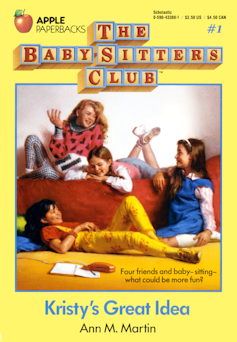
I’m not alone. Kristy’s Great Idea was first published by Scholastic in 1986 and the series has since sold more than 180 million books. The winning formula was a 15-chapter novel written from the perspective of one of the four/five/six/seven/nine club members (there were a lot of changes in line-up over the 15-or-so years of production) with the occasional interjection from another club member in the form of a baby-sitting journal entry, complete with distinctive handwriting.
Each character is distinct, almost archetypal; they’re flawed yet loveable. And the target audience of seven year olds probably didn’t realise 13 is entirely too young to care for a family of children.
Like many book franchises of its era, Martin started the series, writing the first 35 novels, before it was handed over to ghostwriters – one of the BSC writers, Peter Lerangis, also wrote for Sweet Valley High.
The franchise has continued to expand since 1986, including the recent graphic novel versions of the first seven books, drawn by Raina Telgemeier and Gale Galligan.A new Netflix series brings the BSC into 2020 in a way that ensures these essentials are still part of the narrative.
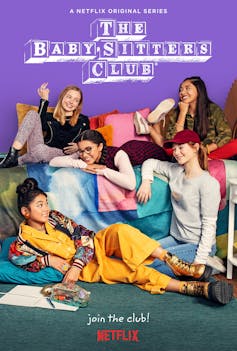
The set-up is the same: Kristy (Sophie Grace) has a brilliant idea while her mum, Elizabeth (Alicia Silverstone – I laughed out loud when Kristy realises her mum isn’t “clueless”), is scrambling to find a baby-sitter to look after her younger brother. Elizabeth is frustrated because no one answers their mobile phone, and she would have to pay $80 to join a website listing sitters. And as Kristy’s friend Claudia (Momona Tamada) observes, they “will then sell her personal information to, like, the Russians.”
In Kristy’s club, the sitters will be in the same place at the same time and reachable on one phone number. They can’t pass out their own mobile numbers because, you know, they’re kids, so they decide to use an “olden times phone”. Luckily, Claudia has a private landline that came with her family’s high-speed internet package.
Flyers are essential because Facebook targeted advertising is far too expensive. Kristy and her best friend Mary Anne (Malia Baker) still need to communicate by flashing torches into each other’s windows when Mary Anne’s dad blocks outgoing calls from her mobile phone. Each episode’s title is even written in the distinctive typeface associated with each character.
For the seasoned fan/nostalgic millennial, it ticks a lot of boxes.
Girls to the front
Both the novels and the new series incorporate preoccupations stereotypically significant for pubescent girls: clothes and crushes and pizza, sure, but also interpersonal relationships, what it’s like to exist in the world in a female body, and balancing what others think of you with what you want to think of yourself.
What’s valuable about both series is these issues of girlhood aren’t relegated as insignificant but rather are validated by their inclusion.
The targeted marketing towards girls also brings up an important ambivalence in children’s literature, where books featuring boys are perceived as being for everyone but books featuring girls are for girls. Books like The Baby-Sitters Club are more likely to be considered light and insubstantial and less likely to be explored for their valuable contributions than books featuring tween boys.
It is important series featuring girls offer readers opportunities to see themselves reflected beyond restrictive stereotypes of femininity. By reflecting a range of characterisations and scenarios, assumptions girlhood is any less dynamic or complex than boyhood are undermined, showing readers female protagonists can be just as powerful as the boys. (Harriet Potter could have been great, just saying.)
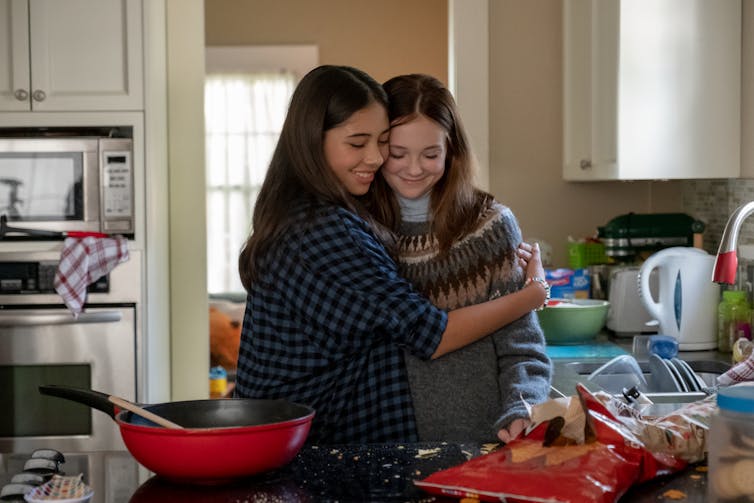
The Netflix series captures Martin’s characterisation while incorporating contemporary concerns.
Kristy knows how to lean in. She is full of brilliant ideas. The kid is smart and knows how to get what she wants. Her 1980s characterisation as a bossy, loudmouth tomboy is, however, a bit jarring in light of contemporary expectations of gender performance. “Bossy” is a gendered pejorative thrown at assertive girls. Likewise, “tomboy” suggests a deviation from more stereotypical feminine traits – those associated with quiet and emotional Mary Anne, “boy crazy” Stacey, or fashionista Claudia.
Kristy likes sports and she wears a lot of turtlenecks (which faithfully appear in the Netflix series – “normcore”, as Mary Anne describes), but the characteristic that truly defines her is simply that she talks. She speaks up and she’s unwilling to accept the disempowerment that tends to come along with her youth and gender.
Read more: Normcore: when being ordinary becomes a fashion statement
In the first episode, Kristy is assigned an essay on “decorum” for speaking up in class, saying Thomas Jefferson should have said all people were created equal (instead of “all men”). She knows she’s expected to stay polite and quiet, but she’s unable to do so when she feels speaking out is necessary. Kristy’s agenda is explicitly feminist.
Kristy is, of course, white and middle class: these factors of identity were a given in the novels but are more politicised in the new series. The neoliberal feminism here is pretty patent. The series’ feminist concerns are about creating a kind of “empowered” girl with the right to do whatever she chooses, with a focus on economic equity. Think breaking glass ceilings, rather than overthrowing the patriarchy.
Socioeconomic status is an interesting element in both the books and television show, simultaneously important and disregarded. One reason Mary Anne, Claudia and Stacey join the club is to make money, but their need for money is relative. The club members are firmly positioned in a middle-class community. While there is the occasional mention of the Thomases finding things difficult because Elizabeth is a single mum with four kids, her marriage to the very wealthy Watson Brewer sorts things out.
The Netflix series does discuss the jarring nature of moving between tax brackets in such a sudden manoeuvre, but there’s little consequence – just the acknowledgement it will take some getting used to.
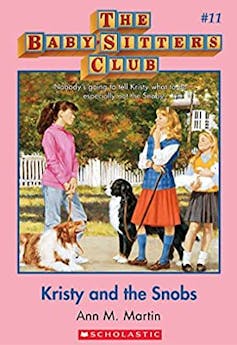
In the books, Kristy doesn’t “change” despite moving to the wealthy side of town – but continuing to wear a baseball cap doesn’t exactly mean having a millionaire as a parent has no effect. In Kristy and the Snobs, Kristy’s wealthy neighbours are initially portrayed as judgemental and nasty, suggesting whether or not you have money is linked to niceness, rather than privilege.
While Shannon ends up being a friend of Kristy (and a member of the BSC), her wealth is part of her characterisation – it contributes to how she sees the world. At first, she and her sisters suggest Kristy lives at “Mr Brewer’s house”, rather than acknowledging it is Kristy’s home. Shannon’s worst offence is being mean about Louie, Kristy’s elderly dog, because he looks a bit rough compared to her purebred Bernese mountain dog.
In the novels, when the characters who live in Kristy’s neighbourhood are described, their wealth is generally acknowledged, but some families are framed as “normal” and friendly (the Papadakises), while others are spoilt, rude and ostentatious (the Delaneys with their $400 cat and $2000 fountain in the front entrance).
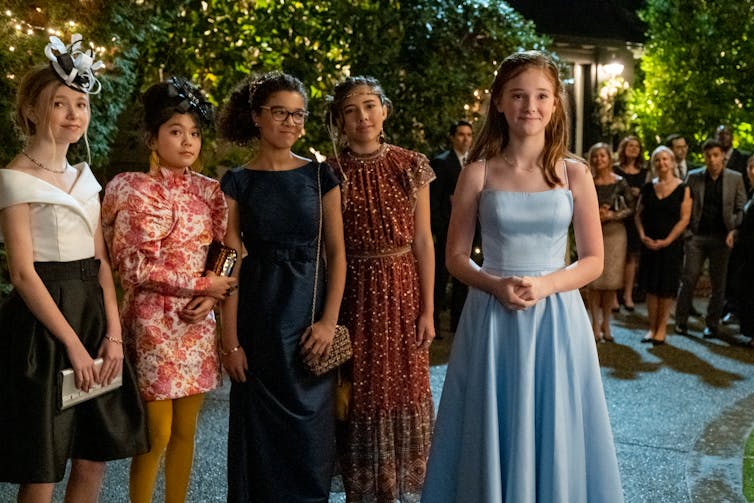
Those who draw attention to their own wealth rather than downplaying it are presented in a mocking fashion. Ignoring your wealth is the expectation. The fact Kristy doesn’t change in response to her circumstances suggests class is static, and shows a lack of awareness of the effects of additional wealth on children’s experiences.
While novels for children don’t need to be explicitly political, the depoliticisation of factors like wealth (and race, as we’ll discuss) contributes to a kind of naïve and idealistic apathy.
We need diverse books
As children’s literature expert Rudine Sims Bishop says, representation of diverse characters in children’s literature is important to allow children to see themselves reflected in texts, as well as offer insights into points of similarity and difference between characters and themselves.
The books incorporate race in a culturally generic rather than specific way: characters aren’t necessarily white and different ethnicities are represented, but there’s no real consideration about what that might mean. Representation is superficial, or possibly tokenistic.
Read more: Bias starts early – most books in childcare centres have white, middle-class heroes
In the novels, Claudia is of Japanese descent and Jessi is Black, but their race is mostly a small detail of their characterisation, like how Dawn has two earrings in each ear or how Mallory hates boys (and gym). But as Jessi acknowledges in Jessi’s Secret Language, after describing herself as Black to the reader: “If we were white, I wouldn’t have to, because you would probably assume we were white. But when you’re a minority, things are different.”

There is an occasional focus on racism (in Hello, Mallory, Jessi moves to Stoneybrook and encounters explicitly racist reactions and comments from schoolmates and neighbours; in Keep Out, Claudia a family specifically requests the blonde, blue-eyed baby-sitters to care for the children) and it is clearly denounced, so the ethical stance of the novels is unambiguous. But apart from a handful of the novels, there is little acknowledgement of the ways being a person of colour in a small town in the pretty white state of Connecticut might be difficult.
Acknowledgement of experiences outside the default position of middle-class whiteness is beyond the scope of the books. Margaret Mackey, an expert on young readers, has written “shading, nuance, and ambiguity are not on the menu” in the series, and, despite ostensibly offering multiple narrative perspectives, each character’s voice is identical.
As such, while the inclusion of people of colour offers important representation, there’s a lack of discussion of the experience and complexities of being a person of colour. It’s the narrative equivalent of the comment “I don’t see race.”
A new complexity
Under showrunner Rachel Shukert (Glow) and executive producer and director Lucia Aniello (Broad City), the new TV series expands representation beyond the novels. Mary Anne is black and Dawn (Xochitl Gomez) is Latina. Dawn’s dad is gay. Mary Anne learns about gender identity and advocates for a young transgender girl she is baby-sitting.
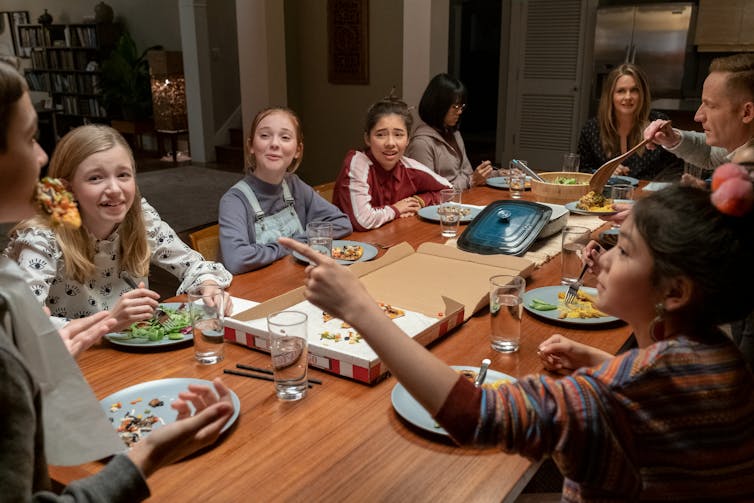
Intersectionality of girlhood and race is a more obvious concern of the new series, although only Claudia’s experience of her heritage is discussed in any detail in the first series.
Episode six, Claudia and Mean Janine, offers an exploration of her liminal experience of her Japanese-ness and American-ness, and her subsequent sense of belonging in both her family and culture. She learns of her grandmother Mimi being forced to live in an internment camp during the second world war, despite being an American citizen – a historical event Claudia was aware of, but not one she felt was related to her.
The novel of the same title focuses more on Claudia’s feelings of insecurity, but the episode touches on the complex experiences of children who feel part of the dominant culture but whose family background carries the trauma of racism, marginalisation and injustice.
Watching now, as an adult and parent, I see how these intergenerational relationships show up in other ways. Mary Anne’s dad (Marc Evan Jackson) is overprotective and anxious, stemming from Mary Anne’s mother’s death – he wants to be the perfect parent and he’s also afraid of losing her. Mary Anne’s insecurity, sensitivity and shyness seem to mirror Richard; she tries to regulate her own behaviours so she doesn’t trigger his fear.
Stacey (Shay Rudolph) misleads her new friends because her mother (Shauna Johannesen) makes her feel she should be hiding her diabetes. Stacey feels her parents are ashamed of her, but her mother only wants to protect her.
The series demonstrates well the way parents’ “good intentions” can be completely misunderstood by their kids, and clear communication is necessary for the results of the misunderstanding not to be damaging.
As Dawn says, “Parents are just older weirdos doing the best they can.”
Now, these girls show engagement with major political concerns in a way that reflects the increasing politics of young people today.
In the two-part finale, Dawn, an unabashed social justice warrior, seeks to change the mindsets of her fellow campers with her unique perspective during the morning announcements.
She encourages the campers to try out for the musical Paris Magic (about “a young woman time-travelling her way through the French Revolution” – the knowing cheesiness is charming) to “save the arts – and the world, which is due for a dose of radical empathy that only the arts can provide”.
She ultimately organises a protest to try to make things more financially equitable for all the campers (considered a mild inconvenience by her friends because of the scheduled performance of the aforementioned play).
And, look, she’s also a hippie and her mum has witch friends and they participate in women’s circles and there’s a lot of finger-snapping as kudos, so there’s a kind of ironic stereotype happening here. But Dawn’s social awareness and empathy offer a contrast to some of the more individualistic storylines. With her focus on the relationship between her external and internal world, her character is the most happy in who she is.
Read more: Do art and literature cultivate empathy?
A story for the ages
The Baby-Sitters Club books are simultaneously wonderful and problematic. It was a group of girls helping women look after children. It shows girls they can run a successful business. The baby-sitters know they can charge less than their adult competitors – in a female-dominated and thus significantly underpaid industry – so why not undercut the competition and secure the market?!
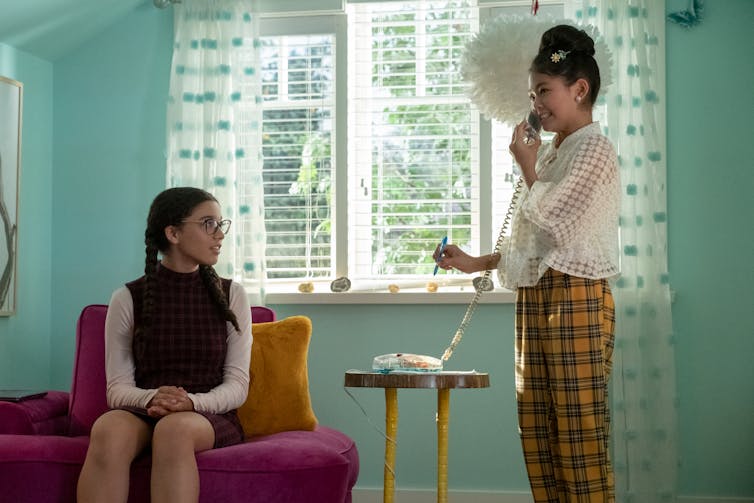
“You wouldn’t believe what some of these adult sitters charge. We could ask for half, and we’d be rich,” says Kristy. Let a 13-year-old girl look after your three children, go on! What could go wrong? They’ll all be just fine!
And they were fine. They always worked it out. They were creative and industrious and great sitters. These books, while encompassing a particular flawed brand of white feminism, offer significant representations of strong girls both speaking up and achieving.
So maybe my condescending tone here stems from the continuing dominant position girls are lacking and inferior, and I should stay focused on those reasons I loved the BSC so much as a kid.
These characters made it seem like you could be shy as hell or really bad at spelling or as whingey as Mallory (sorry, Mallory) and still be completely fine. And, when you’re in primary school, the idea that when you’re 13 you’ll not only have some agency but also be respected and trusted by adults is pretty compelling.
So maybe I’m just resentful because as an adult I have enough trouble looking after my own baby.
Maybe I’m just tired.
Maybe I should call the Baby-Sitters Club.
– ref. Friday essay: need a sitter? Revisiting girlhood, feminism and diversity in The Baby-Sitters Club – https://theconversation.com/friday-essay-need-a-sitter-revisiting-girlhood-feminism-and-diversity-in-the-baby-sitters-club-139767








